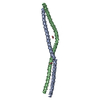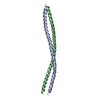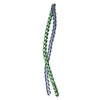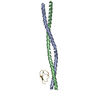[English] 日本語
 Yorodumi
Yorodumi- PDB-2gd7: The Structure of the Cyclin T-binding domain of Hexim1 reveals th... -
+ Open data
Open data
- Basic information
Basic information
| Entry | Database: PDB / ID: 2gd7 | ||||||
|---|---|---|---|---|---|---|---|
| Title | The Structure of the Cyclin T-binding domain of Hexim1 reveals the molecular basis for regulation of transcription elongation | ||||||
 Components Components | HEXIM1 protein | ||||||
 Keywords Keywords |  TRANSCRIPTION / Hexim1 / TRANSCRIPTION / Hexim1 /  transcription regulation / transcription elongation / positive transcription elongation factor-b / P-Tefb NMR / transcription regulation / transcription elongation / positive transcription elongation factor-b / P-Tefb NMR /  structure determination / symmetric dimer / structure determination / symmetric dimer /  coiled coil / MAQ1 / CLP-1 / EDG1 coiled coil / MAQ1 / CLP-1 / EDG1 | ||||||
| Function / homology |  Function and homology information Function and homology information7SK snRNP / 7SK snRNA binding /  snRNA binding / negative regulation of viral transcription / negative regulation of cyclin-dependent protein serine/threonine kinase activity / cyclin-dependent protein serine/threonine kinase inhibitor activity / snRNA binding / negative regulation of viral transcription / negative regulation of cyclin-dependent protein serine/threonine kinase activity / cyclin-dependent protein serine/threonine kinase inhibitor activity /  protein kinase inhibitor activity / negative regulation of transcription elongation by RNA polymerase II / positive regulation of signal transduction by p53 class mediator / P-TEFb complex binding ...7SK snRNP / 7SK snRNA binding / protein kinase inhibitor activity / negative regulation of transcription elongation by RNA polymerase II / positive regulation of signal transduction by p53 class mediator / P-TEFb complex binding ...7SK snRNP / 7SK snRNA binding /  snRNA binding / negative regulation of viral transcription / negative regulation of cyclin-dependent protein serine/threonine kinase activity / cyclin-dependent protein serine/threonine kinase inhibitor activity / snRNA binding / negative regulation of viral transcription / negative regulation of cyclin-dependent protein serine/threonine kinase activity / cyclin-dependent protein serine/threonine kinase inhibitor activity /  protein kinase inhibitor activity / negative regulation of transcription elongation by RNA polymerase II / positive regulation of signal transduction by p53 class mediator / P-TEFb complex binding / activation of innate immune response / protein kinase inhibitor activity / negative regulation of transcription elongation by RNA polymerase II / positive regulation of signal transduction by p53 class mediator / P-TEFb complex binding / activation of innate immune response /  heart development / intracellular membrane-bounded organelle / heart development / intracellular membrane-bounded organelle /  innate immune response / negative regulation of DNA-templated transcription / negative regulation of transcription by RNA polymerase II / innate immune response / negative regulation of DNA-templated transcription / negative regulation of transcription by RNA polymerase II /  nucleoplasm / identical protein binding / nucleoplasm / identical protein binding /  nucleus / nucleus /  cytoplasm cytoplasmSimilarity search - Function | ||||||
| Biological species |   Homo sapiens (human) Homo sapiens (human) | ||||||
| Method |  SOLUTION NMR / torsion angle dynamics, cartesian coordinate simulated annealing SOLUTION NMR / torsion angle dynamics, cartesian coordinate simulated annealing | ||||||
 Authors Authors | Dames, S.A. | ||||||
 Citation Citation |  Journal: Proc.Natl.Acad.Sci.Usa / Year: 2007 Journal: Proc.Natl.Acad.Sci.Usa / Year: 2007Title: Structure of the Cyclin T binding domain of Hexim1 and molecular basis for its recognition of P-TEFb. Authors: Dames, S.A. / Schonichen, A. / Schulte, A. / Barboric, M. / Peterlin, B.M. / Grzesiek, S. / Geyer, M. #1:  Journal: To be Published Journal: To be PublishedTitle: NMR assignment of the Cyclin T-binding domain of human Hexim1 Authors: Dames, S.A. / Schoenichen, A. / Schulte, A. / Barboic, M. / Peterlin, M. / Grzesiek, S. / Geyer, M. | ||||||
| History |
|
- Structure visualization
Structure visualization
| Structure viewer | Molecule:  Molmil Molmil Jmol/JSmol Jmol/JSmol |
|---|
- Downloads & links
Downloads & links
- Download
Download
| PDBx/mmCIF format |  2gd7.cif.gz 2gd7.cif.gz | 1.3 MB | Display |  PDBx/mmCIF format PDBx/mmCIF format |
|---|---|---|---|---|
| PDB format |  pdb2gd7.ent.gz pdb2gd7.ent.gz | 1.1 MB | Display |  PDB format PDB format |
| PDBx/mmJSON format |  2gd7.json.gz 2gd7.json.gz | Tree view |  PDBx/mmJSON format PDBx/mmJSON format | |
| Others |  Other downloads Other downloads |
-Validation report
| Arichive directory |  https://data.pdbj.org/pub/pdb/validation_reports/gd/2gd7 https://data.pdbj.org/pub/pdb/validation_reports/gd/2gd7 ftp://data.pdbj.org/pub/pdb/validation_reports/gd/2gd7 ftp://data.pdbj.org/pub/pdb/validation_reports/gd/2gd7 | HTTPS FTP |
|---|
-Related structure data
| Similar structure data |
|---|
- Links
Links
- Assembly
Assembly
| Deposited unit | 
| |||||||||
|---|---|---|---|---|---|---|---|---|---|---|
| 1 |
| |||||||||
| NMR ensembles |
|
- Components
Components
| #1: Protein | Mass: 12680.050 Da / Num. of mol.: 2 Fragment: c-terminal Cyclin T-binding domain of human Hexim1 (residues 255-359) Mutation: G256A Source method: isolated from a genetically manipulated source Source: (gene. exp.)   Homo sapiens (human) / Gene: Hexim1 (255-359), G256A / Plasmid: pProEx-HTa / Species (production host): Escherichia coli / Production host: Homo sapiens (human) / Gene: Hexim1 (255-359), G256A / Plasmid: pProEx-HTa / Species (production host): Escherichia coli / Production host:   Escherichia coli BL21(DE3) (bacteria) / Strain (production host): BL21(DE3) / References: Escherichia coli BL21(DE3) (bacteria) / Strain (production host): BL21(DE3) / References:  GenBank: 5453682, UniProt: O94992*PLUS GenBank: 5453682, UniProt: O94992*PLUS |
|---|
-Experimental details
-Experiment
| Experiment | Method:  SOLUTION NMR SOLUTION NMR | ||||||||||||||||||||||||||||
|---|---|---|---|---|---|---|---|---|---|---|---|---|---|---|---|---|---|---|---|---|---|---|---|---|---|---|---|---|---|
| NMR experiment |
| ||||||||||||||||||||||||||||
| NMR details | Text: The structure was determined using triple-resonance NMR spectroscopy in solution. |
- Sample preparation
Sample preparation
| Details |
| |||||||||||||||||||||
|---|---|---|---|---|---|---|---|---|---|---|---|---|---|---|---|---|---|---|---|---|---|---|
| Sample conditions | Ionic strength: 50 mM NaCl, 20 mM KPi / pH: 7.2 / Pressure: ambient / Temperature: 308 K |
-NMR measurement
| Radiation | Protocol: SINGLE WAVELENGTH / Monochromatic (M) / Laue (L): M | |||||||||||||||
|---|---|---|---|---|---|---|---|---|---|---|---|---|---|---|---|---|
| Radiation wavelength | Relative weight: 1 | |||||||||||||||
| NMR spectrometer |
|
- Processing
Processing
| NMR software |
| ||||||||||||||||||||
|---|---|---|---|---|---|---|---|---|---|---|---|---|---|---|---|---|---|---|---|---|---|
| Refinement | Method: torsion angle dynamics, cartesian coordinate simulated annealing Software ordinal: 1 Details: The structures are based on a total of 2592 NOE distance restraints, 163 dihedral angle restraints, 102 hydrogen bonds distance restraints, and 80 RDC restraints per monomer. | ||||||||||||||||||||
| NMR representative | Selection criteria: lowest energy | ||||||||||||||||||||
| NMR ensemble | Conformer selection criteria: structures with the lowest energy Conformers calculated total number: 200 / Conformers submitted total number: 20 |
 Movie
Movie Controller
Controller








 PDBj
PDBj